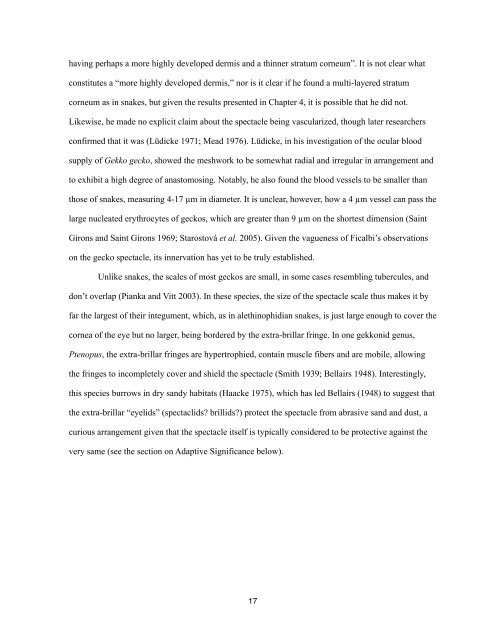Chapter 1, The Reptilian Spectacle - UWSpace - University of ...
Chapter 1, The Reptilian Spectacle - UWSpace - University of ...
Chapter 1, The Reptilian Spectacle - UWSpace - University of ...
Create successful ePaper yourself
Turn your PDF publications into a flip-book with our unique Google optimized e-Paper software.
having perhaps a more highly developed dermis and a thinner stratum corneum”. It is not clear what<br />
constitutes a “more highly developed dermis,” nor is it clear if he found a multi-layered stratum<br />
corneum as in snakes, but given the results presented in <strong>Chapter</strong> 4, it is possible that he did not.<br />
Likewise, he made no explicit claim about the spectacle being vascularized, though later researchers<br />
confirmed that it was (Lüdicke 1971; Mead 1976). Lüdicke, in his investigation <strong>of</strong> the ocular blood<br />
supply <strong>of</strong> Gekko gecko, showed the meshwork to be somewhat radial and irregular in arrangement and<br />
to exhibit a high degree <strong>of</strong> anastomosing. Notably, he also found the blood vessels to be smaller than<br />
those <strong>of</strong> snakes, measuring 4-17 µm in diameter. It is unclear, however, how a 4 µm vessel can pass the<br />
large nucleated erythrocytes <strong>of</strong> geckos, which are greater than 9 µm on the shortest dimension (Saint<br />
Girons and Saint Girons 1969; Starostová et al. 2005). Given the vagueness <strong>of</strong> Ficalbi’s observations<br />
on the gecko spectacle, its innervation has yet to be truly established.<br />
Unlike snakes, the scales <strong>of</strong> most geckos are small, in some cases resembling tubercules, and<br />
don’t overlap (Pianka and Vitt 2003). In these species, the size <strong>of</strong> the spectacle scale thus makes it by<br />
far the largest <strong>of</strong> their integument, which, as in alethinophidian snakes, is just large enough to cover the<br />
cornea <strong>of</strong> the eye but no larger, being bordered by the extra-brillar fringe. In one gekkonid genus,<br />
Ptenopus, the extra-brillar fringes are hypertrophied, contain muscle fibers and are mobile, allowing<br />
the fringes to incompletely cover and shield the spectacle (Smith 1939; Bellairs 1948). Interestingly,<br />
this species burrows in dry sandy habitats (Haacke 1975), which has led Bellairs (1948) to suggest that<br />
the extra-brillar “eyelids” (spectaclids? brillids?) protect the spectacle from abrasive sand and dust, a<br />
curious arrangement given that the spectacle itself is typically considered to be protective against the<br />
very same (see the section on Adaptive Significance below).<br />
17
















